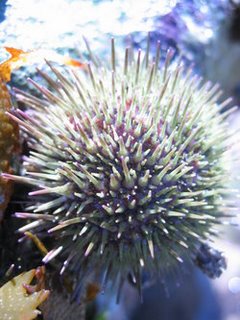
I was moved to do a little research after watching an episode of "Lost" last night in which Dr. Jack uses a sea urchin spine as a needle to give Boone a blood transfusion, and feeling a bit skeptical about the whole concept because I thought sea urchin spines were barbed--not exactly something you'd want to puncture a vein with even if you are as manly and able to endure pain as Dr. Jack. Of course, simultaneously with the blood transfusion, Claire was having her baby in the middle of the jungle with apparently no medical equipment of any kind, I'd like to see Dr. Jack do THAT. At least the birth was more plausible than the sea urchin needle. And I can't find anything that suggests sea urchin spines are hollow as portrayed in the episode. I can suspend a lot of disbelief as long as a TV show or movie doesn't blatantly lie about known facts of the natural world. For example, if there are mutant sea urchins on the island who evolved razor-sharp, hollow, barbless spines due to their exposure to mysterious radio transmissions, that's FINE. But don't just go harvesting any old Pacific urchin and telling boldfaced lies about it.
Meanwhile I discovered that we (humans) have a lot more in common with sea urchins, genetically speaking, than we have with fruit flies. This article says that 70% of urchin DNA has a human equivalent but I'm not sure where they get that figure, elsewhere in the article it said 7,000 or so bits out of 23,000 that they identified from the urchin genome matched human DNA. Maybe I should suspend my disbelief about the math in this article as well.
No comments:
Post a Comment